Laksa Lemak is a seafood noodle soup that calls for shrimp, tofu, boiled eggs, and beansprouts. This Malaysian creamy soup has a coconut milk base that is infused with a homemade spice paste using aromatics such as galangal, lemongrass and shallots. The broth is flavorful and fragrant with a harmonious blend of aromatics and coconut milk, making it a hearty meal when served over cooked noodles and garnished with laksa leaf!
Laksa Lemak is the quintessential fusion food from Southeast Asia. My first exposure to this dish was at the Island Café on Scotts Road in Singapore. After a morning spent shopping, we ended up at the Island Café. My husband highly recommended this dish to me. While reviewing the menu, I was a little confused about what “fish cake” was and if this was of Indian, Chinese, or Malay origin. Curious, I ordered this dish. Admittedly, I was unprepared for what was served and was pleasantly surprised by the rich complexity of flavors.
What is Laksa Lemak?
Variations of laksa are served from Thailand to Indonesia and the flavors reflect the composition of local ingredients. Depending on whom you ask, the etymology of the word ‘laksa’ could be a derivative of the Sanskrit phrase ‘Lakshaa’ meaning hundreds of thousands (as a nod to the explosion of flavors), from the Cantonese “lɐ̀t sá”, spicy sand referencing the gritty texture used by the ground dried prawns, or even from the Persian word referring to noodles.
What makes Laksa unique is that throughout Malaysia and Singapore, every state has its own version. But generally speaking, Laksa Lemak is essentially a seafood broth cooked in coconut milk (see the distinction between lemak and lodeh). Some people get offended when their chicken curry noodle soup is called a “laksa” simply because the sauce can look similar to coconut milk. Virtually every curry-based sauce served in Malaysia and Singapore has coconut milk.
Interesting facts about the ingredients:
Fish Cake: I had heard about fish cakes but struggled to get my head around how they were made and why everyone was raving about it. Fish cake is available in many forms from Western Europe, through Africa, and into the Far East. Although their flavor profiles are different, they all have a common theme. They are essentially fish paste mixed with herbs and spices that have been steamed or fried.
Galangal: Galangal is a part of the ginger family. Colloquially, it is referred to by various regional names including lengkuas (Malay), or kha (Thai), Sankyo (Japanese), or hong dou Kou (Mandarin), or more commonly Thai or blue ginger. While traditional Southeast Asian cooking distinguished galangal from its more popular “ginger”, you can use them interchangeably in small quantities. The flavor difference is that galangal has a sharp sweeter, more citrusy note whereas ginger is spicier and more pungent.
Bean curd: Bean curd or tofu is made from soybeans that have been ground and pressed. A staple of the Far East and Southeast Asian cooking for over two millennia, soybeans are high in protein and low in saturated fats. While tofu comes in many forms, fried tofu (puff or skin formats) is commonly used in broth-based dishes.
Noodles: The traditional noodle for Laksa Lemak is the udon-type noodle. Udon is a wheat-based noodle that is a mild, pale, thick, rounded noodle. These characteristics allow the noodles to ‘hold together well and act as a contrast, tempering the spicy laksa broth. That said, there are variations of laksa that are commercially available that use rice vermicelli or ramen. The key element is to cook these noodles al dente to ensure they are not overcooked when served with the hot broth.
Dried shrimp: Dried shrimp or sun-dried shrimp have a concentrated flavor that allows for longer preservation due to dehydration. A staple of Asian cooking, dried shrimp add a ‘sea-foody’ flavor to any dish. As the shrimp are dehydrated, you should rehydrate them and in some instances, grind and fry them to unlock the flavors.
Candlenuts: The candlenuts are native to Southeast Asia and Australia and have also migrated to the Polynesian cultures. It is known as the kukui nut in Hawaii and is also the state tree. It is also known as the Indian walnut; ‘Buah Keras in Malay, ‘kemiri in Indonesia; and ‘plumbing’ in the Philippines. Fresh nuts can be toxic, so they must be roasted or cooked to lose their toxicity. Roasting the slivers releases the nutty flavors and acts as a thickening agent to the broth. If you can’t get candlenuts for the laksa, you can substitute it with roasted Brazil nuts or even macadamia nuts (as I have done here in my Laksa Lemak recipe). The flavor profile will subtly change from the traditional flavors, but the primary purpose of the candlenut is to thicken the broth while adding a nutty flavor.
Lemongrass: Lemongrass is a common grass grown all over Southeast Asia, and it adds a fresh revitalizing flavor to the dish. Historically, when combined with ginger, this herb is made into a broth that provides nourishment against chills or fever and is said to relieve stress and anxiety.
Laksa leaf: The laksa leaf has a distinct lemon–cilantro flavor and is common in Southeast Asian cooking. It is commonly known as ‘daun resume’ in Malay or Vietnamese cilantro or mint. While it is added as a garnish, its addition as an aromatic is incredible. That said, it is fairly difficult to find this, so you can substitute it with kaffir lime leaves.
Over the years, many locals have told me that Laksa Lemak was not an easy dish to master. In truth, a well-made bowl of laksa can be quite tricky to make, primarily because the delicacy of the broth makes the proportions and balance very important. Food, along with soccer (the locals call it football), is a way of life and the locals are incredibly fervent and opinionated regarding their local dishes and their sport. My husband, who is a third-generation Singapore-Malaysian, can be vociferous in judging his native dishes. So, I am sharing this recipe with a sense of accomplishment, after seeing him smile contentedly every time I make it.
Frequently Asked Questions:
- What are the two basic varieties of laksa?
- Curry laksa focuses on the use of turmeric and coconut milk which is the base of the typical yellow/orange color. The recipe below is based on this construct.
- Assam laksa is based on the use of tamarind. Assam is the Malay word for tamarind (and not to be confused with the state of Assam in India).
2. Can I make the Laksa Lemak vegan or vegetarian?
Yes, you can omit the seafood and dried shrimp and use more tofu to make it vegan or vegetarian.
3. How can I make this dish gluten-free?
I have used buckwheat and sometimes whole wheat noodles as a healthier option in this recipe. To make it gluten-free, please use rice noodles or other gluten-free noodle options by checking the package labels.
If you’ve tried this recipe or have questions, I would love to hear from you. Please feel free to share (below) your thoughts, comments, or any questions that you might have. And if you like my recipes, you could subscribe to my mailing list for the latest recipes that will be delivered to your inbox. From my pen to your table, Bon Appetit!
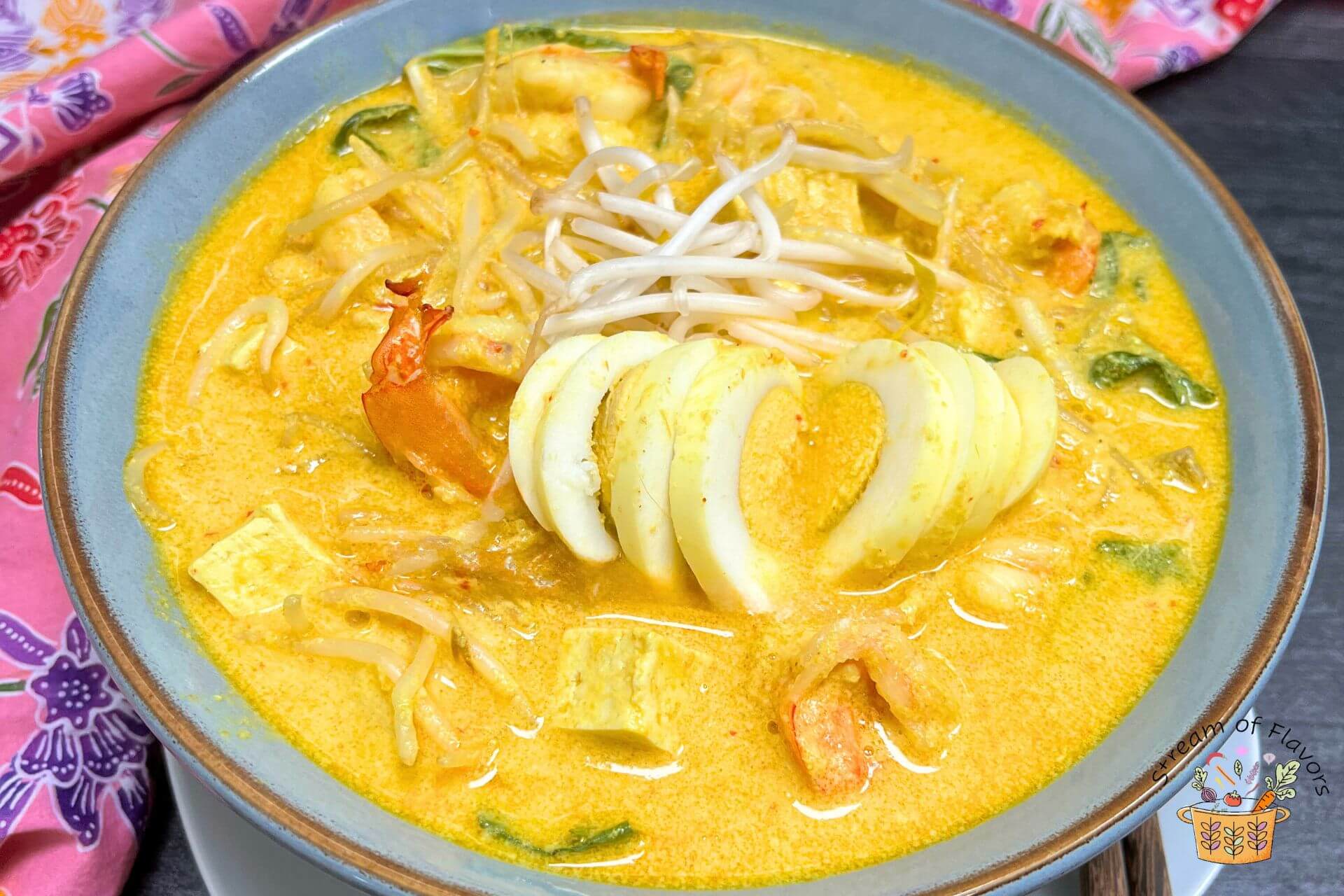
Ingredients:
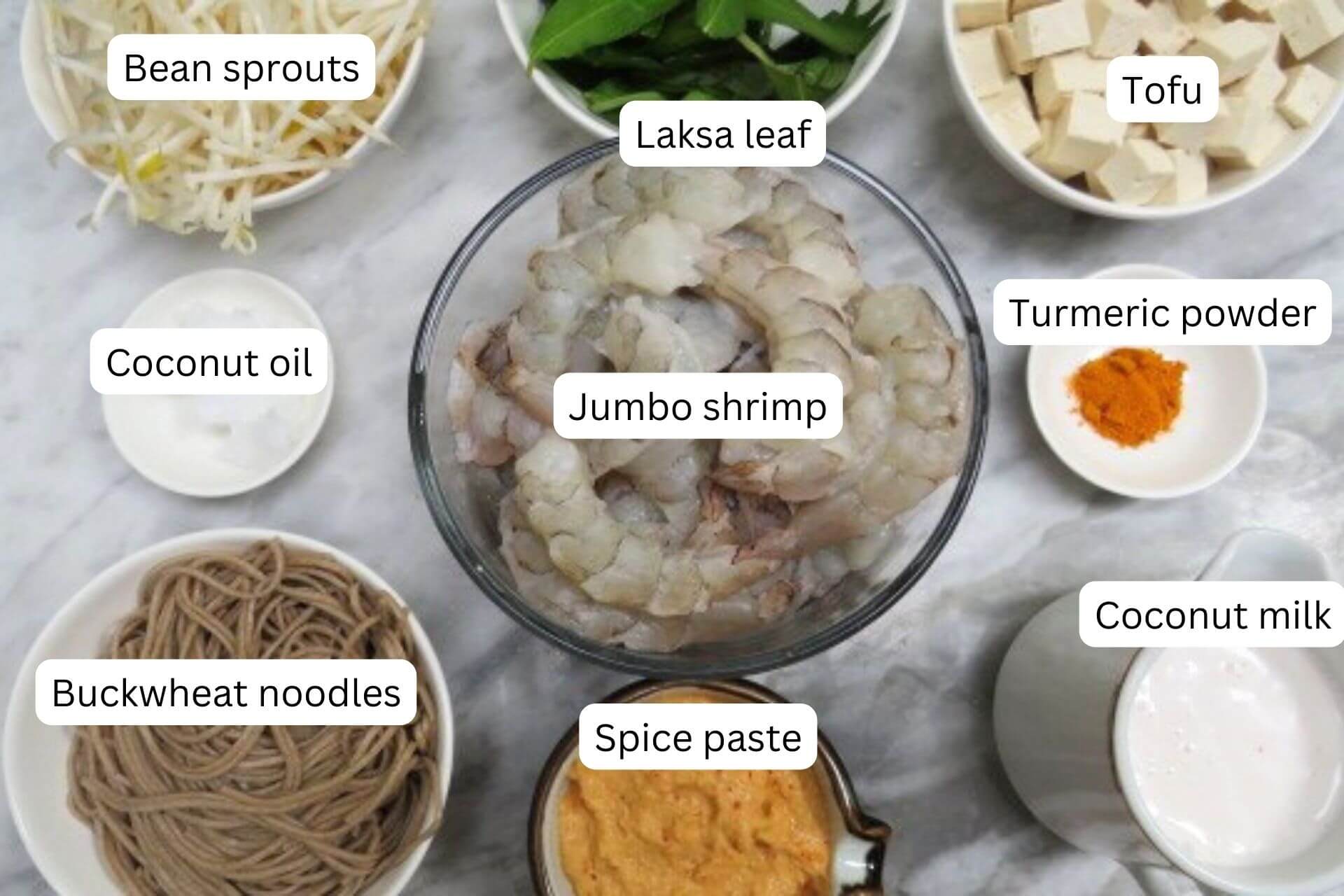
- Spice paste: galangal, Thai red chili, dried red chili, lemongrass, turmeric powder, dried shrimp, and macadamia – use candlenuts if you can find them; galangal is essential to the dish although you could substitute with fresh ginger but it will alter the flavor profile; substitute lemongrass with lemon zest; fresh turmeric can be used after peeling it.
- Protein: jumbo shrimp, tofu and boiled eggs- you can vary by adding fish cake, cockles, mussels, tempeh and quail eggs.
- Broth: fresh coconut milk, vegetable broth – feel free to use canned coconut milk and seafood broth
- Garnish: chives, laksa leaf and bean sprouts – feel free to add cilantro and chopped laksa leaf (kesom leaf or Vietnamese mint).
Here are the step-by-step instructions on how to make this dish. Please refer to the recipe card below for the measurements.
How to make Laksa Lemak:
- Grind the ingredients for the spice paste in a food processor or spice grinder with a tablespoon of filtered water to make a fine paste. Heat a wok and add the coconut oil. Add the spice paste and sauté until slightly brown and fragrant for 3 minutes. Toss the shrimp and sauté for 2 minutes in the spice paste on high heat. Add the tofu and sauté for a minute.
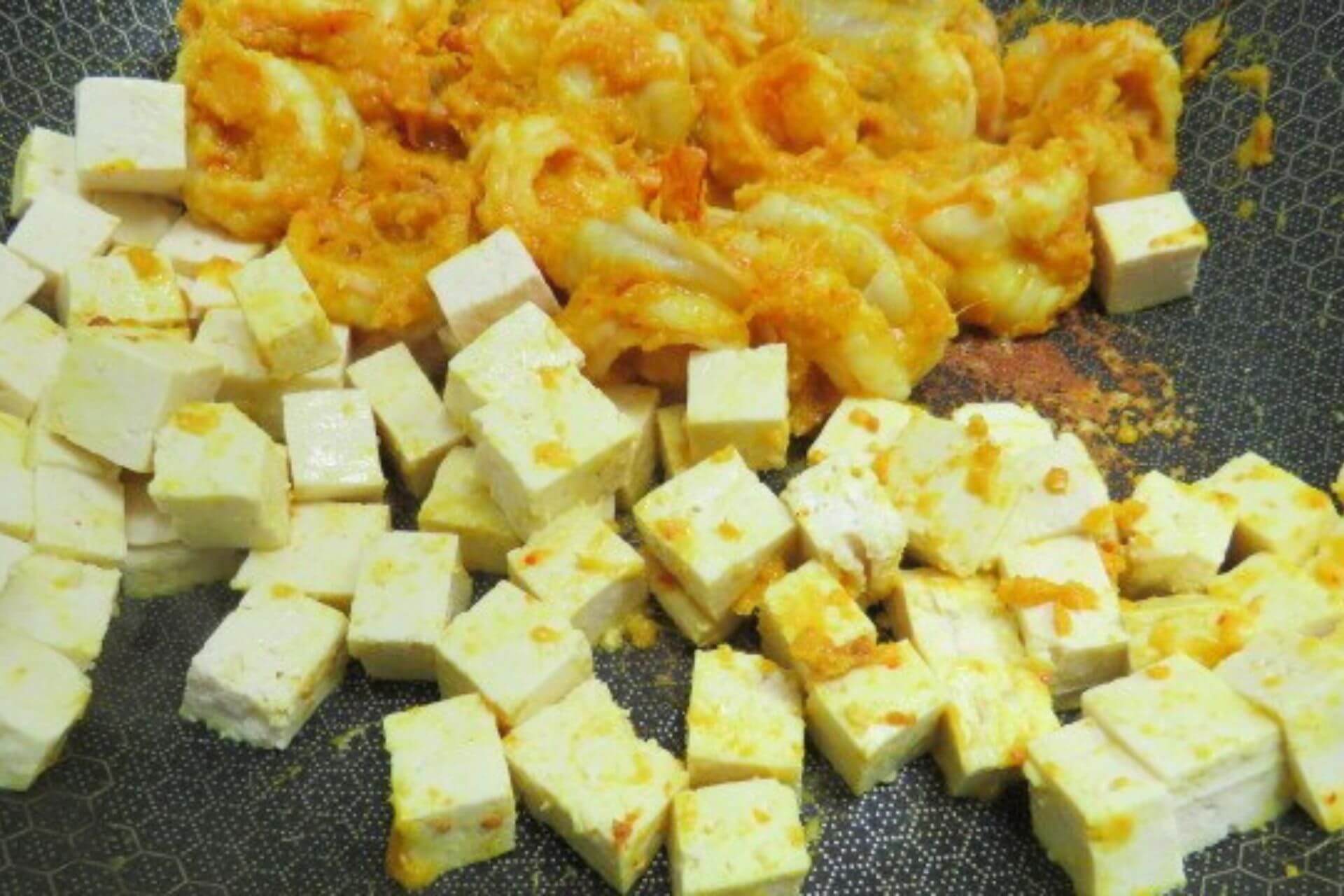
2. Add the fresh extract of coconut milk and vegetable broth. Cook on medium heat until the gravy boils. Turn off the heat and add the laksa leaf, bean sprouts, and boiled eggs. Place some noodles in a deep bowl, scoop some of the Laksa Lemak into it, and serve hot garnished with chives.
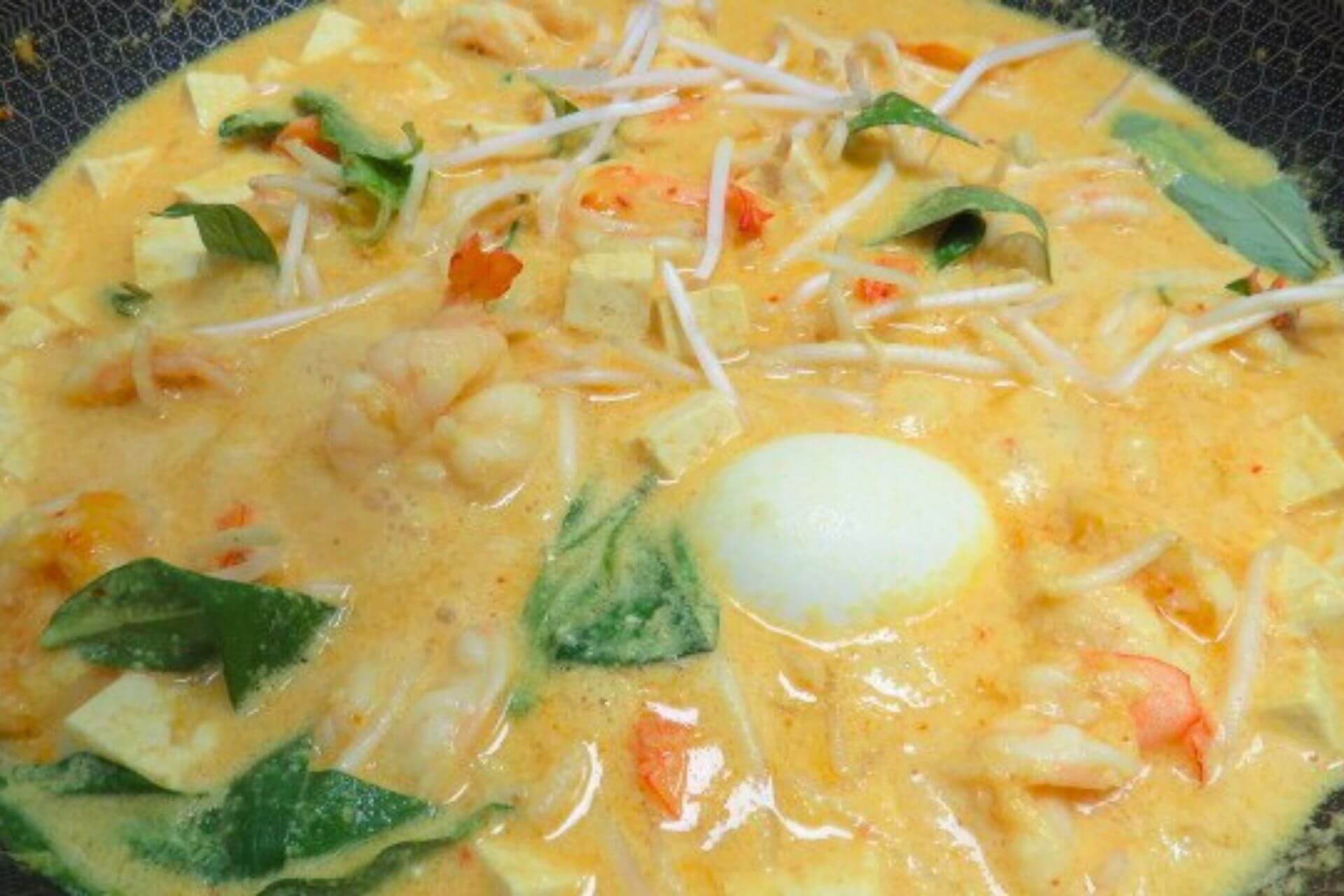
1. Sauté the spice paste until fragrant. Do not hasten this step as the aromatic spice paste will enhance the broth’s flavor.
2. Fry the fish cake or other add-ons before adding to the broth.
3. Cook the noodles to al dente or the noodles will get mushy when hot broth is added.
4. Do not boil the Laksa Lemak when reheating to prevent the coconut milk from separating. Gently reheat on low heat in a pot by stirring the bottom occasionally to prevent the bottom from sticking.
5 If using dried bean curd sticks, soak them in hot water for 3 minutes before adding them to the broth.
Serving suggestion:
- In a pasta bowl or preferably a laksa bowl, scoop some noodles. Pour the broth with the shrimp, bean curd, and boiled egg. Garnish with bean sprouts and chives or laksa leaf. Serve hot.
- Serve it with Singapore Popiah for an appetizer and Bubur Chacha for dessert! It is also served with a side of prawn crackers and a light salad.
Storage:
Laksa Lemak is a seafood noodle soup that will evoke the essence of the sea. It is usually best when consumed the day of making it. But you can freeze leftovers in a freezer box, although it is not recommended. Reheat the dish on low heat in a pot by stirring occasionally so the coconut milk does not separate.
Other noodle recipes that you might like:
Laksa Lemak
Equipment
- Wok (stovetop)
Ingredients
For the spice paste:
- 2½ tbsp macadamia unsalted, roasted
- ½ cup shallot chopped
- 3 dried red chili deseeded
- 2 Thai chili
- 2 tbsp dried shrimp
- ¼ cup galangal peeled, chopped
- 6 lemongrass white part only
- ½ tsp turmeric powder
For the laksa lemak:
- 2 tbsp coconut oil
- 1 lb jumbo shrimp de-veined, tail on
- 14 oz firm tofu cubed
- 3 cup coconut milk fresh from 1 coconut
- 2 cup vegetable broth
- 2 tsp salt
- 4 boiled eggs
- a few laksa leaf Vietnamese mint
- ½ lb beansprout
- a few chives chopped
- 1 lb buckwheat noodles
- ½ pack fish cake optional
Instructions
How to make the Laksa Lemak:
- Prepare the ingredients. Grind the ingredients for the spice paste in a food processor or spice grinder with a tablespoon of filtered water to make a fine paste. Cook the noodles per manufacturer's instructions to al dente by reducing 2 minutes from the suggested cook time. Strain and keep aside.
- Heat a wok and add the coconut oil. Add the spice paste and sauté until slightly brown and fragrant for 3 minutes. Toss the shrimp and sauté for 2 minutes in the spice paste on high heat. Add the tofu and sauté for a minute.
- Add the fresh extract of coconut milk and vegetable broth. Cook on medium heat until the gravy boils. Turn off the heat and add the laksa leaf, bean sprouts, and boiled eggs. Place some noodles in a deep bowl and scoop some of the Laksa Lemak into it and serve hot garnished with chives or chopped laksa leaf.
Video
Notes
- Cockles, mussels, fish cakes, and cooked quail eggs are sometimes used.
- The authentic flavor of the laksa is from the spice paste. Adjust the quantity based on the amount of noodle soup you are making. Store-bought laksa paste does not taste as good as homemade paste.
Nutrition


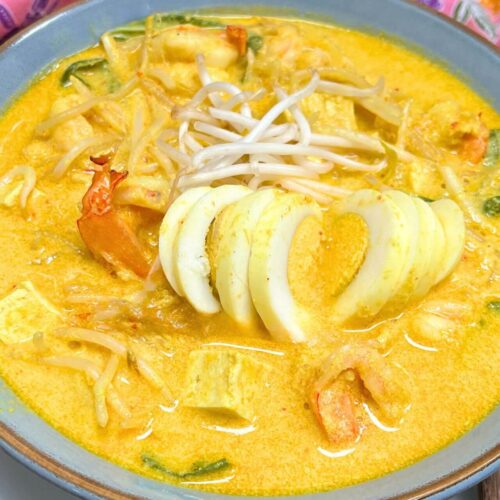
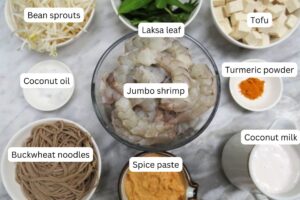
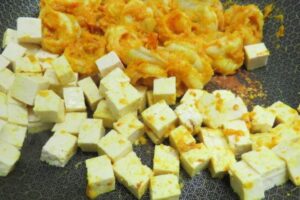
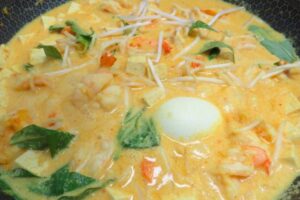




















I love Laksa! Thanks for posting this recipe, now I am able to make it myself!
Danya, you are welcome! Good to hear that you tried it.
Thanks for showing how to make laksa!
You’re welcome, Kate!
A wonderful blend of flavours!
This is absolutely delicious! Well worth the time spent!